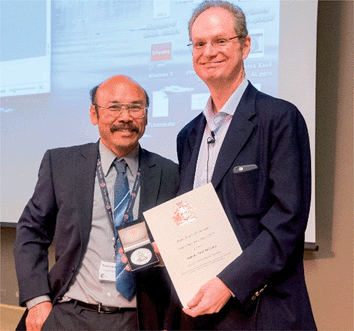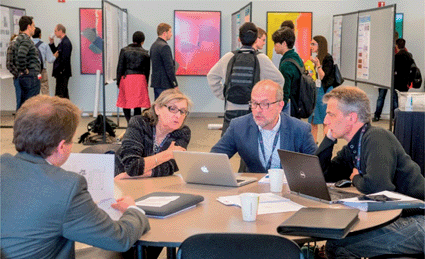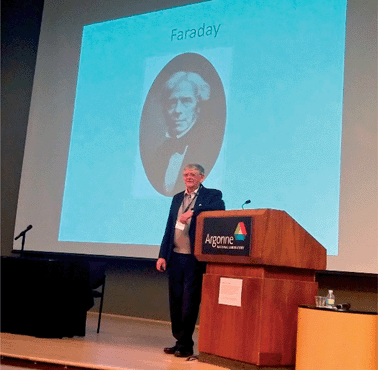Preface
Bruce M.
Law
Department of Physics, Kansas State University, Manhattan, KS, USA. E-mail: bmlaw@phys.ksu.edu
These questions cannot be answered in isolation. A successful attack on these difficult questions requires the coordinated and collaborative effects of NP theorists, NP synthesizers and NP assemblers. The purpose of this particular Faraday Discussion meeting is therefore to bring together these diverse groups of scientists, who share related interests, to foment a synergy that will promote significant advances. The open format of the Faraday Discussion will serve as an ideal environment for presentation of the latest developments in NP theory, synthesis and assembly where the discussion between these disparate groups will generate new ideas and engender new collaborations between these groups.
With these thoughts in mind, the idea of hosting a Faraday Discussion meeting on Nanoparticle Synthesis and Assembly at Argonne National Laboratory near Chicago in the US was formulated. The Committee, composed of 3 US and 3 UK/European scientists, decided upon the Opening and Closing Speakers, Invited and contributing speakers and general meeting format after much debate, spread over a 4 year period. With bated breathe the meeting date finally arrived, 20–22 April 2015, and 125 participants from 25 countries gathered to attend only the third Faraday Discussion meeting to be held in the US in its one hundred year history. After brief welcoming remarks from Alfred P. Sattelberger (Argonne Deputy Director) and Bruce M Law (Chair of the Scientific Committee) the Chair had the delightful pleasure of being able to introduce and present the Opening Speaker, Paul Alivisatos (Director of Lawrence Berkeley National Laboratory), with the Spiers Memorial Award for outstanding accomplishments to the field of nanoparticle synthesis and assembly. Each year the Spiers Memorial Award is given to an Opening Speaker who has made outstanding contributions to a particular Faraday Discussion topic. Frederick Solomon Spiers, the founding secretary of the Faraday Society for 20+ years, “was indefatigable in promoting and organising the succession of discussions which have made the Society known throughout the world”.1
As might be expected, Paul Alivisatos' opening remarks describing in situ Electron Microscopy observations of nanoparticle formation in a liquid medium were extremely well received and generated significant discussion. Paul's introductory lecture was followed by 23 contributed papers and 3 invited discussion remarks spread over 8 sessions in this Monday afternoon to Wednesday lunchtime Faraday Discussion meeting.
Two Monday afternoon sessions discussed new synthetic NP methods where the influence of dissolved gases, ionic species, thermally tunable interaction sites, and biologically controlled synthesis were investigated. Thirty second, single slide Lightning Presentations preceded the Monday evening Poster session and wine reception, which was sponsored by Cogent. Seventy posters, including 40 student posters, from around the world stimulated animated discussion. The Committee had the unenviable and challenging task of judging these student posters whose diversity, excellence and novelty led to lively and friendly discourse. A decision had to be made by the Committee before the Conference Dinner on Tuesday evening, thus, after much Committee debate throughout Monday and Tuesday Igor Fedin's poster on “Probing the surface of nanocrystals with electrochemistry in situ” and Daniela John's poster on “Self-assembly of cyclodextrin-functionalized particles” were each awarded a Student Poster prize.
The Tuesday morning session kicked off with a lively discussion on the synthesis and properties of patchy NPs. This was followed by two sessions describing numerous differing routes for self-assembling novel 1D, 2D and 3D superlattice nanostructures mediated by temperature, ions, ionic liquids, ligands, templated capillary assembly, and wrinkles. The mechanical and plasmonic properties of self-assembled nanostructures completed the Tuesday afternoon session just prior to a well attended facility tour of the Center for Nanoscale Materials at Argonne. Tuesday evenings' Conference Dinner, which was washed down with extensive quantities of wine, was followed by the announcement and presentation of the Student Poster prizes and a hilarious rendition of the Loving Cup Ceremony.
Two sessions on Wednesday morning describing low-current and magnetic field assisted nanoparticle assembly completed the contributed talks for this Faraday Discussion meeting. David Schiffrin provided apt and appropriate Concluding Remarks connecting Michael Faraday's historical investigations of nanoparticle optical properties to the current Faraday Discussion topic on Nanoparticle Synthesis and Assembly.
As Chair of this third Faraday Discussion meeting to be held in the US, I would judge this meeting a resounding success. The frequency of US Faraday Discussion meetings is increasing, which undoubtedly is a healthy development considering the level of interest at this current meeting. (The first meeting in the US was held at the University of Notre Dame, Indiana in 1963 on radiation chemistry (FD36). The second meeting (FD146 on superhydrophobicity) took place 47 years later in 2010 at the Jefferson Hotel in Richmond, Virginia.) My hope is that this current Faraday Discussion meeting will generate continuing interactions and developments in nanoparticle synthesis and assembly and that the style of this meeting may encourage further attendance at future FD meetings or, perhaps, as it did for me, stimulate sufficient interest that a fourth FD meeting is planned for the US in the not too distant future.
The success of this FD meeting was dependent upon the dedication and hard work of numerous people at the Royal Society of Chemistry, Argonne National Laboratory and elsewhere. In particular, a debt of gratitude is owed to my Committee, Chris Sorensen (Kansas State University), Fernando Bresme (Imperial College London), Helmuth Moehwald (Max Planck Institute of Colloids and Interfaces), Philip Moriarty (University of Nottingham) and Xiao-Min Lin (Argonne National Laboratory) whose sound advice determined the overall composition of this meeting. Xiao-Min Lin, as the local host at Argonne, carried much of the organizational burden for this meeting. Thank you Xiao-Min. A similar debt of gratitude is owed to the wonderful organization at the Royal Society of Chemistry who provided unending support and advice in the organization of FD meetings and in the publication of FD volumes, in particular, Alisa Becker, Claire Springett, Heather Montgomery, Elisabeth Ratcliffe, and Chris Goodall provided immediate feedback and sage advice. Undoubtedly, there are other members of their team, who work behind the scenes, to whom I also owe a thank you. A large number of individuals at Argonne ensured the smooth and seamless running of this FD meeting. Special thanks to Jacquelin LeBreck (meeting coordination), Eva Stringer (security clearance and gate pass organization), Carmie White (wine, dinner, lunches, poster board and conference room organization), and Tim Donnelly, Jonathon Schmidt, and Stewart Sulphur who ensured glitch free video, audio and PowerPoint presentations. Sean McBride and Jonghun Lee, our friendly “microphone runners”, ensured a steady stream of questions for the speakers. Thanks are due to Elena Schevchenko, Yugang Sun, and Subramanian Sankaranarayanan who agreed to be session chairs at the last minute. Thank you also to the Center for Nanoscale Materials Users Office for the tour, in particular, thanks to Martin Holt, Julie Emery, Ron Tollner, Andrew DiLullo, and Anand Bhattacharya. Financial support for this Faraday Discussion meeting was provided by Argonne National Laboratory, Kansas State University, the Physics Department at Kansas State University, and Cogent. The availability of this funding for student scholarships, travel and conference costs, as well as entertainment costs etc. is gratefully acknowledged and certainly made the job of the Committee much, much easier. Finally, thank you to the Opening and Closing Speakers, invited and contributing speakers, poster presenters and conference attendees for the stimulating discussion that pervaded this meeting.
Notes and references
- Obituary, Frederick Solomon Spiers, Trans. Faraday Soc., 1926, 22, 207 RSC.
| This journal is © The Royal Society of Chemistry 2015 |



